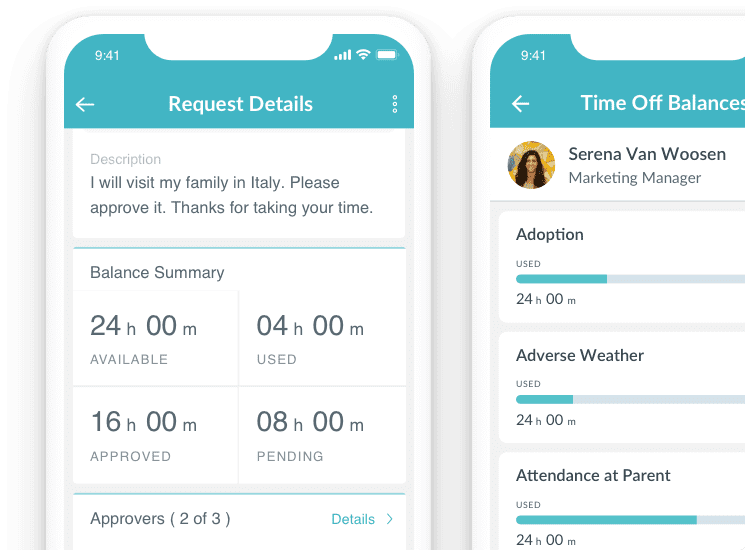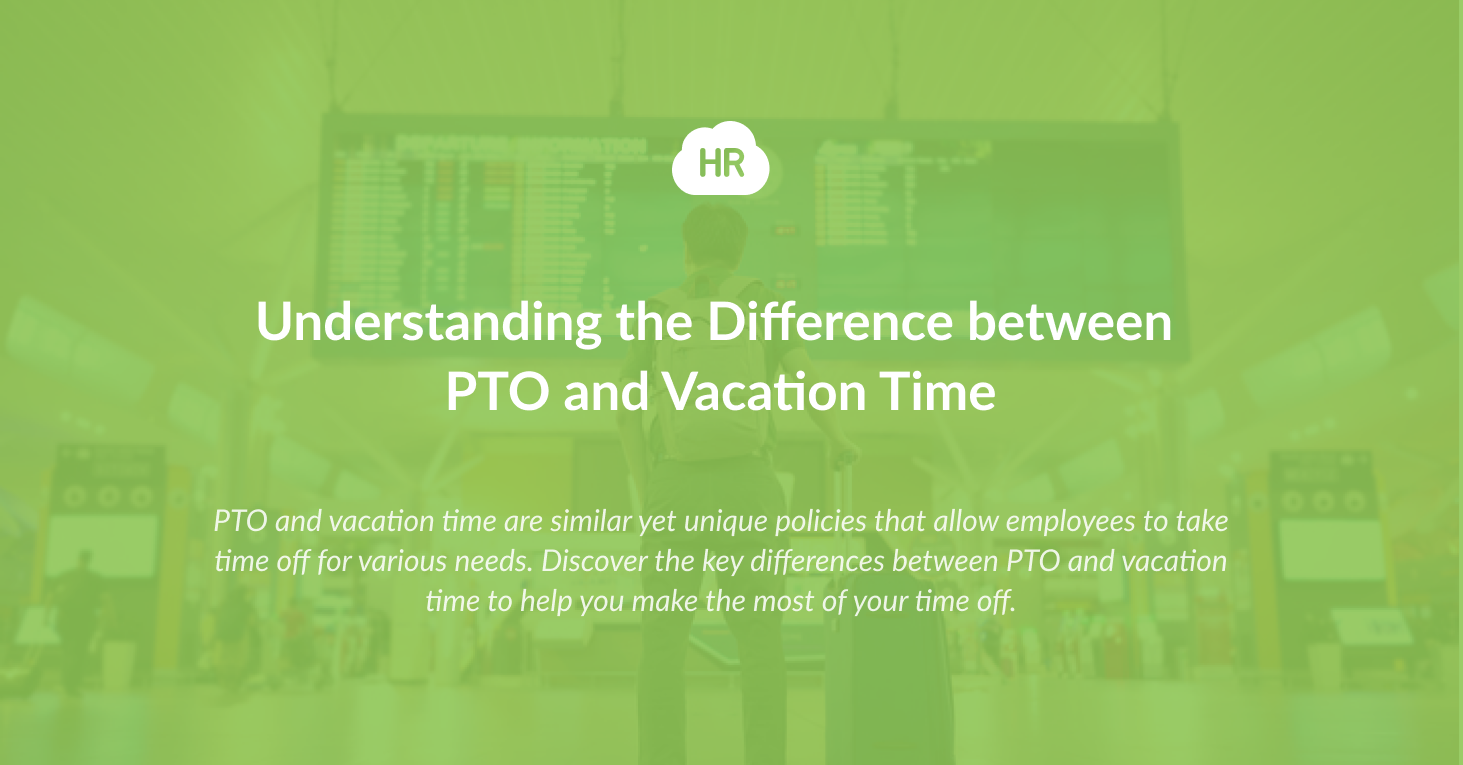Mercer’s 2024 Global Talent Trends report revealed that eight out of ten employees are at risk of burnout this year alone. This highlights just how important taking a break can be and why employees need to take advantage of the leave options they have available.
Paid time off (PTO) and vacation time both offer time off from work, but understanding their differences is essential for employees or managers.
Paid time off is a company policy that grants employees a set number of paid days off from work. PTO combines sick days, personal days, paid holidays, and vacation days under a single umbrella, granting employees more flexibility regarding how they use their allocated PTO days.
Vacation time, while similar to PTO, is a more specific type of time off offered to employees as a break from work. Certain organizations allow employees to use their PTO for vacation, while others don’t include vacation time under this umbrella. Vacation time is typically accrued based on how many years an employee has worked for their organization and their level within their company.
Understanding the differences between vacation time and PTO is essential for securing sufficient time off to limit burnout, rest, and recharge while allowing your company and team to effectively meet their goals.
PTO vs Vacation: Definitions and Usage
PTO: A Flexible Option for Time Off
PTO is a flexible system that provides time off for employees. It’s a broad concept that encompasses both planned and unplanned leave from the workplace and covers a variety of reasons for taking time off, like running errands, handling emergencies and family needs, taking sick days, and embarking on planned vacations.
It encourages a healthy work-life balance and ensures that employees can take breaks when needed to maintain their productivity and performance in the long run.
There are three primary types of PTO policies:
Accrued PTO - This policy rewards employees for their continuous dedication by enabling them to accrue paid time off days based on how long they have worked for a company or how many hours they have worked.
Banked PTO - This unique system offers each employee a set number of paid time off hours at the start of the year or when they are hired. These days can be used for any purpose throughout the year, and some organizations allow unused days to roll over into the next year or provide cash-out options to employees who have not used them.
Unlimited PTO - Having an unlimited number of PTO days offers the greatest flexibility, allowing employees to take as much time off as they need with no set limits in place as long as they manage their time off effectively and maintain smooth workflows. Employees who enjoy unlimited paid time off do not accrue PTO days and will not be paid out for accrued days when they quit or retire.
Depending on the company and the type of PTO policy, this time off may need to be requested well in advance or with minimal notice. If a workforce planning system is in place, the notice period may be shorter as it becomes easier to cover shifts and workloads at short notice. However, if leave is applied for, approved, logged, and requires manually adjusting other employees' schedules, the notice period will need to be longer to avoid impacting the team.
 Photo by Michaela on Pexels
Photo by Michaela on Pexels
Vacation Time: Structured Time Off
Vacation time is somewhat less flexible than PTO and is intended to allow employees a chance to relax, rest, and unwind or take a break from work and travel. This type of paid time off is usually planned well in advance to assist teams in handling workflows while an employee is out of the office.
Vacation time often includes restrictions on the maximum number of consecutive days off and will be tracked if separated from other forms of work leave. Most employees have separate rules and quotas for personal days, sick leave, and vacation days to maintain productive operations while allowing workers to take a well-deserved break.
Pros and Cons of PTO and Vacation Time
PTO Advantages
-
Paid time off offers a great degree of flexibility in taking time off for a number of purposes, both planned and unplanned.
-
PTO can be used to prevent employee burnout by allowing them to take breaks from work when needed.
-
PTO covers a variety of time off needs, from sick days and personal days to family obligations and vacation time.
PTO Disadvantages
-
Paid time off does not distinguish between sick days and vacation days.
-
PTO systems can pose some difficulty in planning ahead due to possible restrictions and specific quotas.
-
Some PTO systems may offer potentially shorter maximum vacation periods, which can limit how long employees can embark on vacations.
Vacation Time Advantages
-
Vacation time offers time off specifically designated to allow employees to relax, recuperate, and enjoy recreational activities.
-
It encourages advanced time off planning to ensure an optimal work-life balance.
-
Vacation time policies provide a clear separation between work time and personal time.
Vacation Time Disadvantages
-
Vacation time policies offer limited flexibility for taking unexpected time off from work.
-
Some organizations impose restrictions on consecutive days off, which may make for shorter vacations.
-
The amount of vacation time an organization offers may not be sufficient to meet a range of personal needs.

Making the Choice: Which is Right for You?
Factors to Consider when Choosing Between PTO and Vacation Time
As an employee, the best choice between PTO and vacation time depends on your circumstances and specific needs.
One key factor to consider is your work-life balance goals and how each type of leave will impact your ability to reach these goals and maintain your desired balance.
Another factor to consider is your current family obligations and any health concerns you may experience. If, for instance, you have ongoing family or health obligations, a PTO policy with ample sick days and personal days on offer may better suit your purposes than a standard vacation time policy.
Even company culture and unique organizational policies should be considered to help you make the ideal choice. Startups may be more likely to prioritize flexible leave, while larger, more well-established organizations tend to opt for structured PTO and vacation time plans.
Tips for Maximizing the Benefits of PTO or Vacation Time
Using a few key methods, you can maximize the potential benefits of both vacation time and paid time off.
Firstly, try to plan ahead for time off wherever possible to ensure that you can issue your request for leave in a way that gives your organization’s administrators enough time to plan around your absence.
Secondly, communicate clearly and efficiently with your colleagues and supervisors regarding your time off to ensure they can prepare for your leave without compromising their projects or workflows. Effective communication keeps everyone on the same page, puts you and your team at ease, and enables HR departments to streamline the process of tracking your PTO accruals and usage.
Thirdly, use smart resources to carefully plan for and maximize your time off. Tools like vacation rental services, travel booking sites, local leisure guides, and travel discounts and promotions can simplify and streamline the process of preparing for your time off while reducing unnecessary stress. Other useful tools include outdoor activity rental platforms, health and wellness apps, and entertainment and cultural events listings. These can enhance your vacation and give you everything you need to recharge effectively.
 Photo by Andrea Piacquadio on Pexels
Photo by Andrea Piacquadio on Pexels
In Summary
While vacation time is a type of paid time off, these policies vary in flexibility, uses, and purposes.
Vacation time is designated specifically to help employees recharge and relax, while PTO covers a wider range of needs, from sick leave and family responsibility leave to bereavement, personal needs, and more.
.png?width=521&height=427&name=_-%20visual%20selection%20(1).png)
Author Bio:
This article is written by a marketing team member at HR Cloud. HR Cloud is a leading provider of proven HR solutions, including recruiting, onboarding, employee communications & engagement, and rewards & recognition. Our user-friendly software increases employee productivity, delivers time and cost savings, and minimizes compliance risk.
If your company uses time-off tracking software, submit your request through the platform, review your available balance, and follow the approval process.
Keep Reading
Retention Reset: How to Keep Your Best Talent in 2025
More employees are walking away from their jobs in 2025 not just for better pay, but for
Remote Onboarding Done Right: A Step-by-Step Guide for HR Teams
Remote onboarding is the process of welcoming new employees who work from home or

